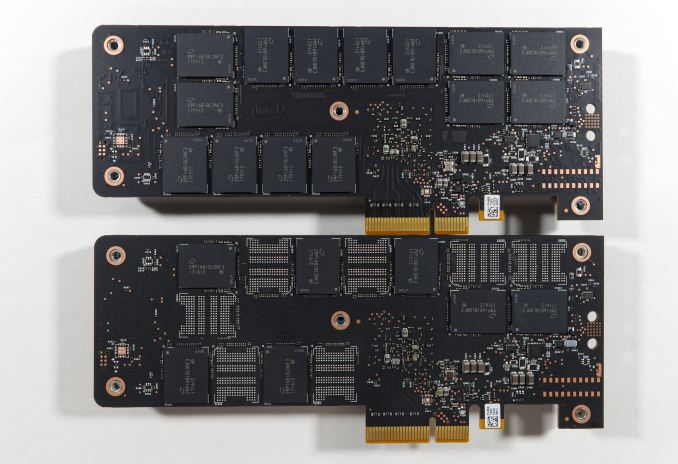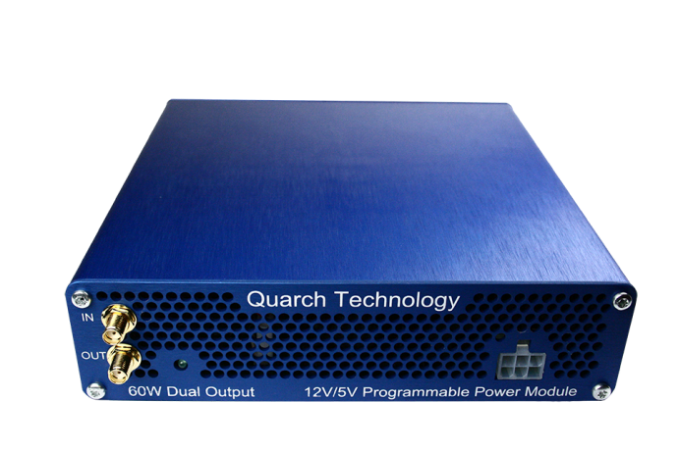The Intel Optane SSD 900p 480GB Review: Diving Deeper Into 3D XPoint
by Billy Tallis on December 15, 2017 12:15 PM EST
Our first look at the Intel Optane SSD 900p only included the smaller 280GB capacity. We now have added the 480GB model to our collection, and have started analyzing the power consumption of the fastest SSDs on the market.
This second look at the Optane SSD 900p doesn't change the overall picture much. As we speculated in our initial review, the design of the Optane SSD and its 3D XPoint memory means that performance does not scale with capacity the way most flash-based SSD designs do. The Optane SSD 900p uses a controller with seven channels for communicating with the 3D XPoint memory. The difference between the 280GB and 480GB models is merely a difference of three or five 3D XPoint dies per channel. Of the 28 memory package locations on the PCB, the 280GB model populates 21 with single die packages. The 480GB model uses all 28 spots, and half of the packages on the front are dual-die packages.
A single NAND flash die isn't enough to keep one of the controller's channels busy, because flash takes many microseconds to complete a read or write command, and even longer for erase commands. By contrast, 3D XPoint memory is fast enough that there is little to no performance to be gained from overlapping commands to multiple dies on a single channel. Increasing the number of dies per channel on an Optane SSD affects capacity and power consumption but not performance.
Intel recently let slip the existence of 960GB and 1.5TB versions of the 900p, through the disclosure of a product change notification about tweaks to the product labeling. The specifications for the larger capacities have not been confirmed but likely match the smaller models in every respect except power consumption. Since Intel has not officially announced the higher capacities yet, no MSRP or release date is available.
| Intel Optane SSD 900P Specifications | ||||
| Capacity | 280 GB | 480 GB | 960 GB | 1.5 TB |
| Controller | Intel SLL3D | |||
| Memory | Intel 128Gb 3D XPoint | |||
| Interface | PCIe 3.0 x4 | |||
| Form Factor | HHHL Add-in card or 2.5" 15mm U.2 |
HHHL Add-in card | HHHL Add-in card (U.2 unknown) |
|
| Sequential Read | 2500 MB/s | TBD | ||
| Sequential Write | 2000 MB/s | TBD | ||
| Random Read IOPS | 550k | TBD | ||
| Random Write IOPS | 500k | TBD | ||
| Power Consumption | 8W Read 13W Write 14W Burst 5W Idle |
<20.5 W | <24 W | |
| Write Endurance | 10 DWPD | TBD | ||
| Warranty | 5 years | TBD | ||
| Recommended Price | $389 ($1.39/GB) | $599 ($1.25/GB) | TBD | TBD |
Our SSD power measurement equipment burned out right before our first Optane SSD arrived. As of this week, we have newer and much better power measurement equipment on hand: a Quarch XLC Programmable Power Module. We'll explore its capabilities more in a future article. For now, we're filling in the missing power measurements from the past several reviews. Both of the Optane SSD 900p models have been re-tested with the Quarch power module on the entire test suite except for The Destroyer (so far). We haven't yet thoroughly validated the new power measurements against the results from our old meter so there may be some discrepancies, but the Optane SSDs draw so much power that any minor differences won't matter to this review. Everything that was tested with the old meter will eventually be re-tested on the Quarch power module, but we don't expect significant changes except to idle power measurements (where the Quarch power module should offer higher resolution).
Our first review of the Optane SSD 900p included a few puzzling results, most notably slightly higher performance when the ATSB Heavy and Light tests were run on a filled drive than when the Optane SSDs were freshly erased. One potential factor for this has since come to light: After first being powered on, Intel Optane SSDs perform a background data refresh process. This isn't necessary unless the SSD has been powered off for a long time, but the drive has no way to know how long it was without power. The documentation for the 750GB Optane SSD DC P4800X states this process can take up to three hours. We have not observed any clear transition in idle power during the first few hours after power-on, but there are occasional short periods where idle power drops by around 350-400mW (from around 3.5W).
Without a conclusive indication of whether background data refresh is happening and influencing benchmark results, we've re-tested the 280GB Optane SSD 900p for this review. Before running the synthetic benchmarks, the 900p was allowed to sit at idle for at least three hours. The ATSB tests were also conducted after an extended idle period, but the test system was rebooted between ATSB tests. Even with this precaution, there's still significant variability between test runs on the Optane SSD 900p and the full-drive performance is often better than freshly erased, so it appears there's another factor contributing to this behavior.
| AnandTech 2017 SSD Testbed | |
| CPU | Intel Xeon E3 1240 v5 |
| Motherboard | ASRock Fatal1ty E3V5 Performance Gaming/OC |
| Chipset | Intel C232 |
| Memory | 4x 8GB G.SKILL Ripjaws DDR4-2400 CL15 |
| Graphics | AMD Radeon HD 5450, 1920x1200@60Hz |
| Software | Windows 10 x64, version 1703 |
| Linux kernel version 4.12, fio version 2.21 | |
- Thanks to Intel for the Xeon E3 1240 v5 CPU
- Thanks to ASRock for the E3V5 Performance Gaming/OC
- Thanks to G.SKILL for the Ripjaws DDR4-2400 RAM
- Thanks to Corsair for the RM750 power supply, Carbide 200R case, and Hydro H60 CPU cooler
- Thanks to Quarch for the XLC Programmable Power Module and accessories












69 Comments
View All Comments
thestryker - Friday, December 15, 2017 - link
I'm curious if the power consumption on the u.2 version would be any different.Any chances of Intel hooking AnandTech up with a u.2 version? I know the storage bench system doesn't have u.2, but I'm sure there's a system around which does. I believe there's also a sku with m.2 to u.2 adapter also.
Billy Tallis - Friday, December 15, 2017 - link
The U.2 drive uses the same 12V supply as the add-in card, unlike SATA SSDs that use 5V. Any differences in power consumption would probably be minor variations due to different operating temperature.CheapSushi - Friday, December 15, 2017 - link
It's been so satisfying to see all the Optane haters, dismissers, general naysayers and "meh, ___ is good enuff" crowd, who pretend to be enthusiasts, finally backtracking on their comments about it. Good times.tricomp - Saturday, December 16, 2017 - link
Can't wait seeing my customer's jaws dropping... I build heavy multi-core workstations for 3D and post production. Using 480 jet like this for the OS is something they will truly appreciatemapesdhs - Monday, December 18, 2017 - link
Responsiveness, etc. with pro apps wasn't tested here. Where's the evidence it would be any better than a 960 Pro? I'd be more interested in a Puget Systems review with real world situations.tricomp - Monday, December 18, 2017 - link
I agree with mapesdhs. The main strength of this unit should be tested and compared, not to mention - mentioned - in an article called "deeper diving into 3D Xpoint"lilmoe - Saturday, December 16, 2017 - link
Pardon the ignorance, but is can XPoint memory packages run on lower voltages, or is operation dependent on a single constant voltage setting? Are there any plans for low-power based XPoint like LPDDR or DDRL? If so, I wonder how much performance and latency would degrade.As it is, these will never be able to compete with NAND in terms of power. Lots of users (like) me want this kind of power on the go. Samsung and others are simply NOT trying anymore. I've REALLY delayed purchasing a mobile workstation till these technologies get sorted out and it's clear for me what type of expansion I'll need for compatibility.
wanderer66 - Saturday, December 16, 2017 - link
There won't be mainstream memory modules until late next year, based on what I've read. I wouldn't count on seeing mobile workstation/laptop capability until 2019 or 2020, and that depends on several things: 2nd or 3rd gen optane modules using less power (due to die shrinkage), and a reference design from Intel that supports them on that kind of motherboard. Even then count on them consuming 10-15 watts for a loaded configuration.wanderer66 - Saturday, December 16, 2017 - link
Two things: This is first gen Optane architecture. *First Gen* sisters and brothers... In the next several years, performance will evolve as the controllers improve (greater parallelism and other performance tweaks), power usage will decrease as process optimization and die shrinkage improves, and the design moves beyond being able to use NVMe as the interface, which it will.Second, 550k iops. That's mind-blowing, really. This may not be hugely important to single-user workstations, but in the hosting/cloud markets, this is one of the largest leaps that can be made..
In five years time, Optane will be to flash SSDs what flash SSDs are to HDDs today.
djayjp - Sunday, December 17, 2017 - link
Would *really* like to see real world testing, not traces. In such tests no difference is ever apparent between the bargain basement SSDs and the absolute top tier, thus the current tests AT uses are nonsense.